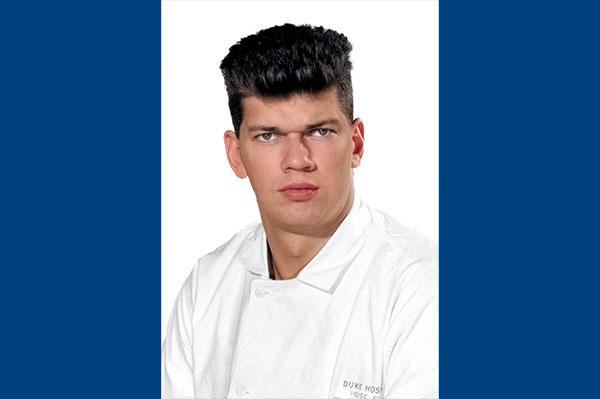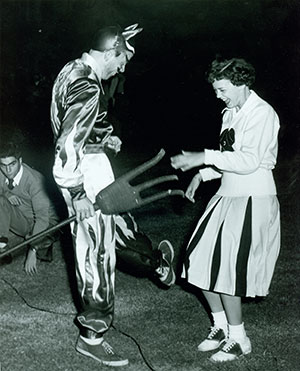Centennial Spotlight: The Blue Devil Med Student: A Tale of Service and Mystery

When not behind a 1950s microscope, Alphonse Von Schoote, a junior assistant pathology resident, could be found beneath Duke’s most coveted mask: its Blue Devil mascot, becoming the first medical student to strut its coveted cape.
“They got some orthopedic netting around his head and some long john’s from someplace, and we finally found some Duke blue dye,” said fellow med student Jerry Adamson, MD. “He was so animated that everybody in the stadium thought, wow, and they were all cheering him and applauding him.”
Adamson loved sharing stories of Von Schoote’s first game against Navy. In an unforgettable moment, Von Schoote dashed toward the Navy sideline, grabbed their live goat mascot, and began to carry it over to Duke’s side of the field. Although he managed to lift the goat, Navy fans quickly swarmed him, tossing him up and down before he escaped and collapsed on the Duke bench.
Not just a symbol of school spirit, Von Schoote also left a legacy in the medical field. After completing his Duke residency in 1958, Von Schoote’s life took a fascinating and ultimately tragic turn.
In the aftermath of WWII, he embarked on a medical mission trip to the South Pacific, where he served as a public health physician in the Truk Archipelago, now called Chuuk. His work in this remote location was marked by a deep commitment to the health and well-being of local populations, many of whom lived in areas near nuclear testing sites in the Marshall Islands.

Von Schoote's involvement in humanitarian service caught the attention of scientists and researchers, notably Aaron Brill, a longtime ABCC (Atomic Bomb Casualty Commission) scientist, who had been interested in exploring the health effects of nuclear exposure on island populations. His fascination with Von Schoote's work was further fueled by Von Schoote's dedication to improving health outcomes in regions severely affected by post-war activities.
The 1950s in Chuuk were particularly challenging for local populations due to the long-term health effects from World War II activities, especially the aftermath of Operation Hailstone. The underwater wreckage from the battle, including sunken ships and aircraft, posed significant environmental hazards, such as contamination of the water and food supply from leaking fuel and munitions. These conditions contributed to a rise in health issues like skin diseases and gastrointestinal problems, making Von Schoote's medical mission even more critical.
Von Schoote continued his medical training in pathology at several U.S. institutions and was deeply respected by his peers for his ability to blend medical expertise with a heartfelt dedication to those in need. His specific focus on parasitology and tropical medicine positioned him as a valuable asset in improving the health of island natives, who were dealing with a complex set of post-war health challenges.
Tragically, Von Schoote’s mission ended in mystery. In 1969, while attempting to replenish medical supplies, he was caught in a storm and disappeared at sea. Letters from ABCC and fellow colleagues show that his efforts in the South Pacific had not gone unnoticed. His untimely death left a gap in the field of tropical medicine and pathology, where his work was just beginning to make significant impacts. His contributions, both as the first Blue Devil and as a dedicated physician, continue to be remembered by those whose lives he touched.
Credit for uncovering these details goes to Rebecca Williams of the Duke Medical Center Archives, whose research, alongside that of Aaron Brill, Rebecca Pattilloand other colleagues, has shed light on Von Schoote's dual role as both Duke's Blue Devil mascot and a dedicated humanitarian.